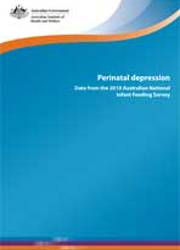Summary
Data from the 2010 Australian National Infant Feeding Survey showed that 1 in 5 mothers of children aged 24 months or less had been diagnosed with depression. More than half of these mothers reported that their diagnosed depression was perinatal (that is, the depression was diagnosed from pregnancy until the child’s first birthday). This represents an estimated 111,000 mothers being diagnosed with depression, and of these 56,000 with perinatal depression. Further, of all the cases of diagnosed depression, just over 1 in 5 were diagnosed for the first time during the perinatal period of the infant selected for the current survey.
The majority of mothers suffering from perinatal depression sought treatment from their general practitioner (GP) and support from family and friends.
Perinatal depression was more commonly reported among mothers who:
- were younger (aged under 25)
- were smokers
- came from lower income households
- spoke English at home
- were overweight or obese
- had an emergency caesarean section.
Location also influenced the prevalence of perinatal depression. For example, mothers living in Major cities and Remote/Very remote areas reported slightly lower rates of perinatal depression than those from other geographical areas.
Perinatal depression was less commonly reported among mothers who had higher levels of education (bachelor degree or higher), were working at the time of the survey, and primarily spoke a language other than English at home.
Box 1: Terms used in this paper
Perinatal depression
The perinatal period extends from when pregnancy begins to the first year after the baby is born. The term perinatal depression includes a wide range of mood disorders that can affect a woman during pregnancy and after the birth of her child. It includes prenatal depression, the ‘baby blues’, postpartum depression and postpartum psychosis.
Prevalence
Prevalence is a frequently used epidemiological measure of how commonly a disease or condition occurs in a population. It measures how much of some disease or condition there is in a population at a particular point in time.
Preliminary material: Acknowledgments; Abbreviations
1 Introduction
2 Objectives
3 Main findings
3.1 Prevalence of depression
3.2 Timing of diagnosis
3.3 Treatment sought or received for perinatal depression
3.4 Source of treatment or assistance for perinatal depression
3.5 Support for perinatal depression
3.6 Completion of depression-related questionnaire
3.7 Factors associated with perinatal depression
4. Explanatory notes
Appendix A: Depression module used in the 2010 Australian National Infant Feeding Survey
End matter: List of tables



